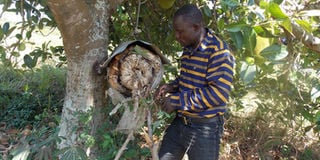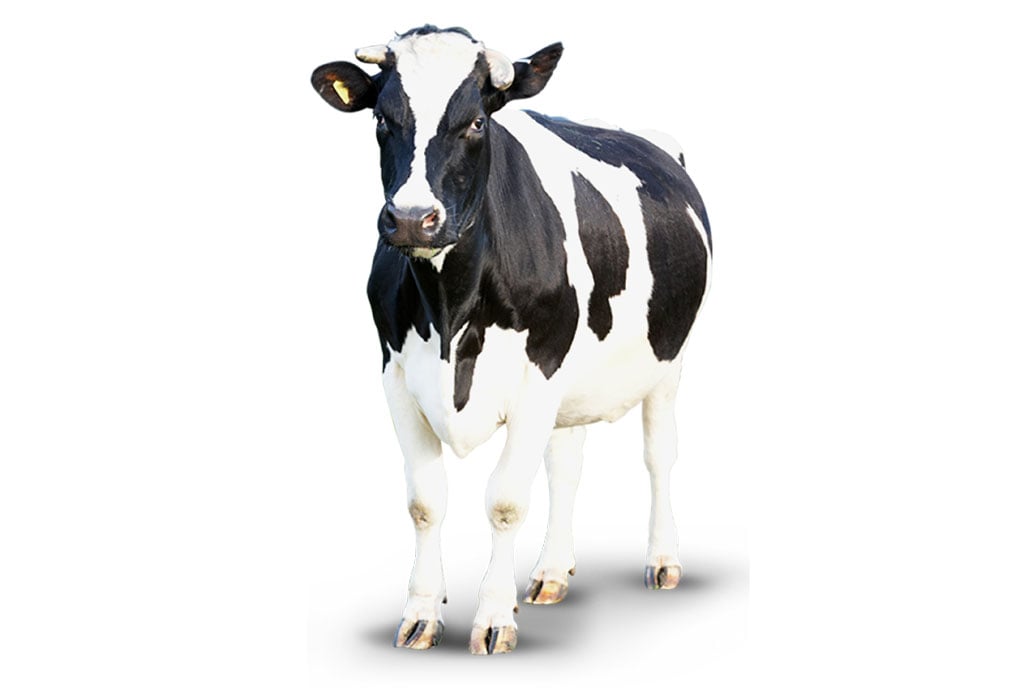Bees will give honey and money

Ssemanda inspects a beehive. the farmer says it is good practice is to hang the beehive under the shade of trees such as mangos, jack-fruit or in a coffee plantation Photos | Michael J Ssali
What you need to know:
- Bees are not only interesting to keep but can also put lots of cash in your pocket. Set your apiary in a well-drained, less disturbed place far from noise or human activities. Keep off areas frequently sprayed with chemical pesticides to reduce bee poisoning and honey contamination.
By Michael J Ssali
Two friends, Fred Ssemanda and Emmanuel Karamaje, of Ngereko Village in Kisekka Sub-county, Lwengo District are beekeepers who have a lot of interesting ideas about why every farmer should keep bees.
“Nowadays, with the encouragement of Lwengo Local District administration, we have volunteered to traverse the entire district talking to farmers about the importance of beekeeping,” Ssemanda tells Seeds of Gold.
The two friends, in their early 40s, have taken advantage of the ongoing political campaign rallies to address small gatherings about bee keeping as the village members wait for the politicians to arrive.
“You do not have to own a lot of land to keep bees,” Ssemanda continues “On an acre, it is even possible to have one thousand bee-hives. We are not really saying everybody should have as many bee-hives on an acre. Just imagine a coffee or banana farmer had some 15 bee-hives kept on his farm.”
Here in Uganda, honey is harvested three times a year and with good husbandry practices from one beehive it is possible to harvest five litres. Now if you harvest 75 litres and sell each litre at Shs30,000, which is the average local price now, you get Shs2.25m.
Remember you can harvest three times a year; so you could end up earning Shs6.75m annually as supplementary income to coffee or bananas.
Moreover, by keeping bees on your farm, you increase your crop production since bees are agents of pollination.
Lessons
Ssemanda picked most of his bee keeping skills from his parents who were traditional beekeepers.
“Most of what I know about bees was taught to me by my parents. They taught me how to make bee-hives out of vines and reeds collected from the forests. But we could also make bee-hives from hollowed tree stems,” he says. He has a tall palm tree in his compound which he hopes to cut down one day to make beehives. His parents taught him what to feed the bees in order to increase honey yields. They also taught him how to harvest honey.
Best practices
“Bees are extremely far sighted. They will see flowers that are miles away,” he said.
“They will, therefore, travel long distances in search of nectar and pollen to bring home to their bee-hive. As a farmer, you should not encourage them to go so far away in search of nectar or water or any other food materials.”
Plant a lot of flowers and flowering trees near the beehive. Another good practice is to hang the beehive under the shade of trees such as mangos, jack-fruit or in a coffee plantation. They like a dark, cool, and quiet environment. Direct sunlight hitting on the bee-hive makes them uncomfortable and may force them to migrate to other locations. When the bees travel long distances searching for flowers or water they could be captured by some birds and get eaten. Some may fail to return and die due to exhaustion.

Karamaje (right) and Ssemanda inspect a beehive.
Drinking water
He further says a little water should be placed fairly near the bee-hive for the bees to drink. “It is better for the water to be dripping slowly from a container rather than putting it in a basin where they could drown. If a shallow basin is to be used for this purpose any remaining water should be removed and replaced every day. The bee keeper should inspect the beehives regularly, clearly following the calendar to get an idea when there is likely to be honey for harvest.”
Make friendship with bees
His partner, Karamaje, says it is possible to strike a friendship with the bees. He says they always know a friend who cares for them such as a person who will put some sugared water near their bee hive or the person who usually works and walks around the bee-hives. “Bees don’t want people who battle them,” says Karamaje. “If a bee comes your way, the best thing is not to try to fight her. Most times she will not sting you if you keep your peace.”
Benefits
A trained school teacher, Ssemanda says he got attracted to bee-keeping because as a business, it is far more paying than teaching. “It provided extra income for me,” he says.
“My parents were able to send us to school using money earned from selling honey. With money that I have earned from bee-keeping, I have been able to build my own school and buy a personal car. My wife and children live in our own house. At the moment, we sell our honey locally at Shs30,000 per litre and we are satisfied with the price at which we sell. Today schools are closed due to the Covid-19 pandemic but we continue to earn some money out of beekeeping.”
The two own 100 beehives some of which are in Kiryandongo District. With the money raised from bee-keeping Ssemanda and Karamaje, have been able to partly fund the activities of a local NGO, Organisation to Mobilise Orphans Disabled Insane and Needy Groups (OMODING) that supports disadvantaged groups in Lwengo District.
Facts about bees
A farmer intending to start bee keeping will purchase beehives that he can afford, ranging from the traditional cylindrical type made out of dry vines and reeds to the Kenya Top bar hive which is rather expensive but very good.
Every beehive should have sufficient space for the bees to make several honeycombs and it should have some holes where the bees will pass and to let in oxygen.
Ssemanda says placing a little honey or a small piece of the honey comb inside a new beehive will attract bees to settle in it.
Ssemanda recommends that beehives should be placed in places where termites and safari ants cannot attack them. “Termites can destroy the wood of which the beehives are made. Nearly all insects eat honey and you don’t want to lose any honey. Rats also can steal the honey and a beekeeper must guard against them.”
He also has an idea about what goes on inside the beehive. He says there is a queen bee in every bee-hive. He says the queen lays about 1,500 eggs every day and that she produces a chemical substance that puts all the bees in the beehive under her subordination.
That substance, known as pheromone, prevents the development of ovaries in all the other bees which, like her, are female and also inhibits the building of queen cells in the combs where rival queens could be bred. The queen has a lifetime of about five years but with time she fails to produce sufficient pheromone perhaps due to old age or due to the big number of bees.
Scarcity of the pheromone where there are lots of bees creates room for a new queen to be bred. The old queen then leaves with several hundreds of bees to settle elsewhere while the new queen builds up a new kingdom where the old queen has been.
Inside the beehive are some male bees. These are few and only one of them has an opportunity to mate with the queen which happens only once. The rest of the males are idle all their lives. They don’t sting and are entirely harmless. The rest of the bees inside a beehive are female whose organs are made useless for reproduction by the pheromone from the queen. Their main occupation is to get nectar and pollen and other substances to make royal jelly to feed the queen and collect honey for her offspring (young ones hatched from the queen’s eggs). Sometimes they clean the beehive by taking out what is not needed.
The honey is what the farmer periodically takes away as his harvest. Ssemanda says, “The honey accumulates in the combs and during harvesting, the farmer must not take away all the combs since there are young bees to be fed on the honey. He also said that during harvesting, the farmer should not kill the bees buy burning. “We use a smoker to sedate the bees so that it is possible to remove the honeycombs peacefully. The farmer is also advised to use gloves and to wear a net.”




